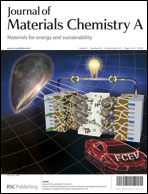Effect of the phase-separated structure on CO2 separation performance of the poly(amidoamine) dendrimer immobilized in a poly(ethylene glycol) network†
Abstract
The poly(amidoamine) (PAMAM) dendrimer is stably immobilized in a poly(ethylene glycol) (PEG) network upon photo-crosslinking of PEG dimethacrylate (PEGDMA) in the presence of the dendrimer. Structural analysis of the resulting polymeric blend by laser scanning confocal microscopy (LSCM) reveals polymerization-induced phase separation on a micron scale and the formation of a bicontinuous structure of PEG-rich and PAMAM dendrimer-rich phases. The average dendrimer domain size, which is identical to the average spacing of the PEG-rich phase, is determined to be 2.2–2.8 μm depending on the PEG length when the dendrimer content is 50 wt%. When a membrane is fabricated using the polymeric blend, the resulting membrane shows excellent CO2 separation properties over H2 especially under higher humidified conditions. The CO2 separation properties under humidified conditions are associated with the dendrimer domain size in the dry state. A smaller dendrimer domain size gives higher CO2 permeance and CO2/H2 selectivity under humidified conditions. Absorbed water induces diffusion of the dendrimer into the PEG-rich phase, which gives rise to the enhancement of the solubility of CO2 in the polymeric blend. As a result, the permeation of CO2 will be more facilitated by the diffused dendrimer, providing a higher CO2/H2 selectivity.


 Please wait while we load your content...
Please wait while we load your content...